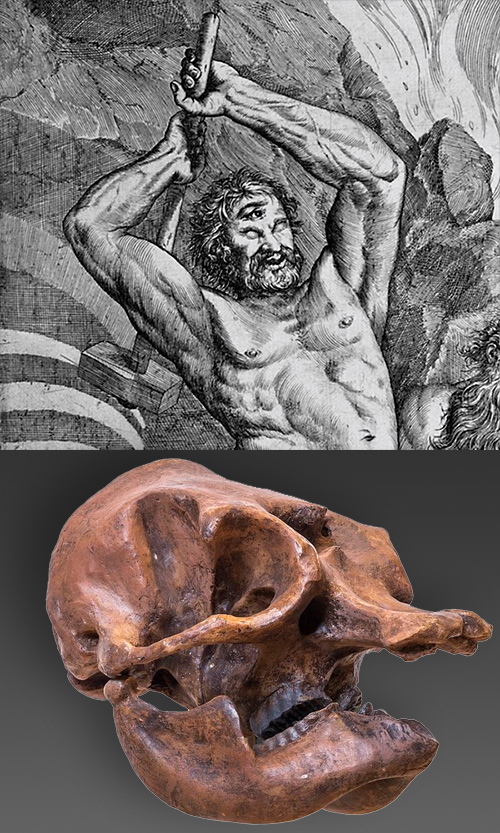
Below: Skull of Palaeoloxodon falconeri, a now-extinct Pleistocene dwarf elephant from the Mediterranean region. Cyclopes myths were thought to have developed from observation of these skulls. Credit: Matteo De Stefano/MUSE (CC BY-SA 3.0 [http://creativecommons.org/licenses/by-sa/3.0]), via Wikimedia Commons
From a previous EarthDate, you may remember that some mythological creatures were born when ancient cultures discovered fossils and created stories to explain them.
Well, here’s a famous beast that started as a tiny elephant.
During the Pleistocene ice ages, polar ice and continental glaciers held more of Earth’s water, causing sea level to fall.
During low sea-level periods, elephants from Africa walked and swam across a nearly dry Mediterranean to Europe. Once seas rose again, some were trapped on islands like Sicily.
When a population gets stuck on an island, it will often overstress its food reserves and be forced to adapt—something called island rule.
These elephants shrunk to survive on less food, and on Sicily got as small as 3 ft tall and 250 pounds.
Once adapted, they did quite well, with no natural predators…
That is, until man arrived, 11,000 years ago. Overstressing their own food reserves, early tribes hunted the small elephants to extinction.
Some of their bones ended up in caves, where tribes lived or cooked. And thousands of years later, the Greeks discovered them.
The elephants’ skulls were about twice the size of a human’s—with a single hole in the middle where the trunk would have been.
Having never seen an elephant, the Greeks imagined these were the skulls of giants with one large eye: the dreaded cave-dwelling Cyclopes—which then appeared in Greek mythology and rose to fame in Homer’s Odyssey.
Background
Synopsis: Fossil dwarf elephant skeletons from Italy and Greece with skulls twice the size of a human head were interpreted by Greeks—who had never seen an elephant—as single-eyed Cyclopes because the nasal cavity was a large hole in the center of the elephant’s skull. These fossils are particularly abundant in Sicily, and most of the Cyclopes tales start there. How did the elephants get there, and what happened to them?
- The Cyclopes of Greek myths were repulsive, single-eyed, humanlike giants who served as the blacksmiths to the gods from their caves in the bowels of Mt. Etna in Sicily. Some were said to be maneaters.
- Volcanic eruptions of fire, ash, and rocks were thought to be the result of blacksmiths working for the Greek god of fire, Hephaestus (Vulcan, in Roman mythology).
- Three Cyclopes storm gods—Arges (thunderbolt), Steropes (lightning), and Brontes (thunder)—were said to be the first blacksmiths. They were imprisoned and later released by Zeus and fought for him against the Titans. As a reward for their release, the Cyclopes gave Zeus his weapons of lighting and thunder. They were also said to have also forged Poseidon's trident and Hades' invisibility helmet.
- In Homer’s tale of Odysseus, the explorer and his crew found food in a cave while returning from the Trojan War. As they happily filled their bellies, the maneating Cyclops Polyphemus came home to his cave and began filling his belly—with the trespassers!
- When Polyphemus asked Odysseus his name, Odysseus said, “Nobody.” Later that night, Odysseus and the remaining crew drove a stake into Polyphemus’s eye. He screamed, “Help! ‘Nobody’ is attacking me!” This confused the other Cyclopes who lived nearby, so they didn’t respond. (Surviving crew finally escaped by tying themselves to the bellies of Polyphemus’s sheep.)
- The story of the dwarf elephants of the Mediterranean islands is just as compelling as the myths of one-eyed monsters that their skulls and skeletons generated.
- During the Pleistocene ice ages (2.6 million to 11,700 years ago), cycles of glaciation caused sea level to rise and fall repeatedly, creating land bridges that probably enabled large, straight-tusked elephants to walk or swim to nearby emergent islands around the Mediterranean to escape predators or find food sources for their huge, 200-kg-of-food-per-day appetites.
- As sea levels isolated the various islands, the elephants overstressed food resources and adapted by shrinking in size, generation by generation. This dwarfing, called island rule, improves the survival chances of a species when limited food resources pressure a population and extinction is a real possibility.
- Some dwarf species were only 3 ft tall and weighed less than 250 lb.
- The isolated elephants evolved into different species on different islands: Palaeoloxodon falconeri (Pygmy elephant) was common on Sicily and Malta; Palaeoloxodon mnaidriensis was found only on Sicily; and Palaeoxodon cypriotes (Cyprus dwarf elephant)—about twice the size of the others at 6 ft tall— was found only on Cyprus. Dwarf elephants also evolved on the islands of Japan.
- Because predators were absent on many of the Mediterranean islands, the tiny elephants survived in groups on islands like Sicily. That is, until the first humans made their way to the island about 11,000 years ago—the elephants were easily hunted and became extinct within about a century.
- When Greeks and Romans explored the islands, they found many skeletons with skulls about twice the size of a human skull. Thus, the mythological Cyclopes were born from the graves of the tiny pachyderms.

